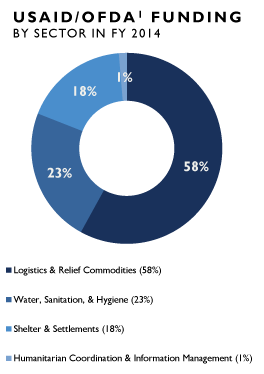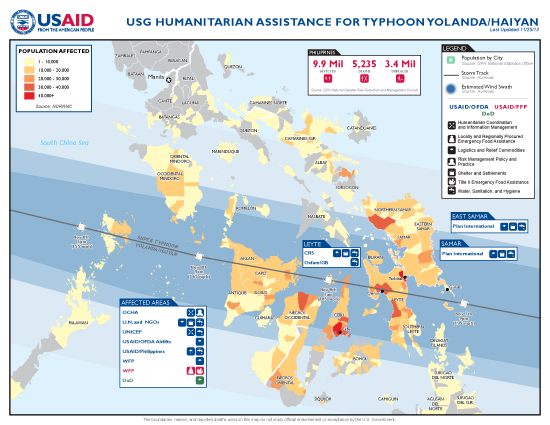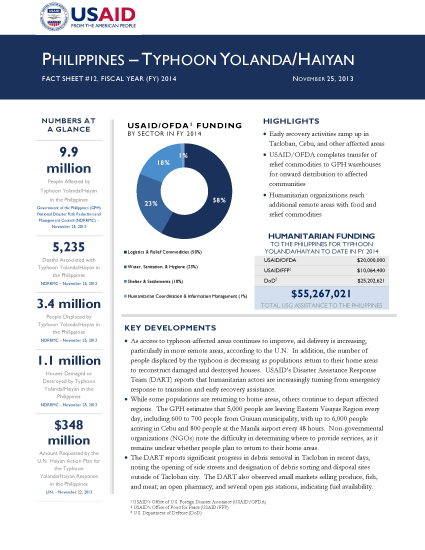- What We Do
- Agriculture and Food Security
- Democracy, Human Rights and Governance
- Economic Growth and Trade
- Education
- Environment and Global Climate Change
- Gender Equality and Women's Empowerment
- Global Health
- Humanitarian Assistance
- Transformation at USAID
- Water and Sanitation
- Working in Crises and Conflict
- U.S. Global Development Lab
Speeches Shim
November 25, 2013
Numbers At A Glance
9.9 million
5,235
3.4 million
1.1 million
$348 million
Humanitarian Funding:
To The Philippines For Typhoon Haiyan/Yolanda To Date In FY2014:

| USAID/OFDA | $20,000,000 |
| USAID/FFP | $10,064,400 |
| DoD | $25,202,621 |
| TOTAL | $55,267,021 |
Typhoon Haiyan / Yolanda Fact Sheet #12 - 11/25/2013 ![]() (pdf - 231k)
(pdf - 231k)
Highlights
Early recovery activities ramp up in Tacloban, Cebu, and other affected areas.
USAID/OFDA completes transfer of relief commodities to GPH warehouses for onward distribution to affected communities.
Humanitarian organizations reach additional remote areas with food and relief commodities.
Key Developments
As access to typhoon-affected areas continues to improve, aid delivery is increasing, particularly in more remote areas, according to the U.N. In addition, the number of people displaced by the typhoon is decreasing as populations return to their home areas to reconstruct damaged and destroyed houses. USAID’s Disaster Assistance Response Team (DART) reports that humanitarian actors are increasingly turning from emergency response to transition and early recovery assistance.
While some populations are returning to home areas, others continue to depart affected regions. The GPH estimates that 5,000 people are leaving Eastern Visayas Region every day, including 600 to 700 people from Guiuan municipality, with up to 6,000 people arriving in Cebu and 800 people at the Manila airport every 48 hours. Non-governmental organizations (NGOs) note the difficulty in determining where to provide services, as it remains unclear whether people plan to return to their home areas.
The DART reports significant progress in debris removal in Tacloban in recent days, noting the opening of side streets and designation of debris sorting and disposal sites outside of Tacloban city. The DART also observed small markets selling produce, fish, and meat; an open pharmacy; and several open gas stations, indicating fuel availability.
LOGISTICS AND RELIEF COMMODITIES
- Civilian and private-sector commercial capacity has significantly increased during the past week. Several DoD C-130 aircraft remain in the Philippines to support deliveries of USAID-validated relief commodities to affected areas. The USS Ashland and USS Germantown continue ship-to-shore logistics for the relief effort.
- On November 25, DoD transported 36 metric tons (MT) of U.N. World Food Program (WFP) food commodities to five outlying islands near Guiuan on November 25. To date, DoD has transported approximately 1,810 MT of relief commodities to typhoon-affected areas, including Borongan, Guiuan, Ormoc, and Tacloban. DoD has also evacuated approximately 540 American citizens, 19,600 Filipino citizens, and 300 third-country nationals from typhoon-affected areas.
- As of November 25, DART logistics officers had facilitated the transfer of all USAID/OFDA-provided relief commodities, including collapsible water containers, from the Tacloban airport to warehouses managed by the GPH Department of Social Welfare and Development (DSWD) for onward distribution.
PROTECTION
- The U.N. Population Fund (UNFPA) has launched a plan for national authorities and humanitarian partners to provide protection support to the more than 3.2 million women and girls in need of assistance in the wake of Typhoon Yolanda/Haiyan. UNFPA has requested $30 million for the next six months to support the deployment of female police officers in 196 municipalities, help create women-only spaces in evacuation centers, strengthen interagency protection mechanisms in 700 villages and barangays, and improve access to maternal and reproductive health care services.
- The Child Protection Working Group released an updated snapshot of the current needs and risks based on pre-crisis and post-crisis secondary data, as well as information gathered after similar emergencies. The report identifies psychosocial distress, physical violence, child labor, and sexual violence as the most urgent needs and risks.
- The U.N. Office for the Coordination of Humanitarian Affairs (OCHA) reports the identification of 36 unaccompanied and separated children in Salcedo municipality, Eastern Samar Province. In general, assessment data indicates that few children have been separated from their parents or usual caregivers; however, the risk of family separation remains. Several regions—including Western and Central Visayas—have also been identified as high-risk for trafficking, and protection experts note the risk for children affected by the disaster to become involved in criminal activity as the economic situation erodes.
- On November 23, the DART assessed the DSWD-managed evacuation center at Villamor Air Base in Manila, which DSWD established to monitor possible cases of trafficking and unaccompanied, separated, or missing children. The DART reports that all evacuees are registered at the evacuation center upon arrival in Manila and provided with a meal, clothes, medical services, and psychosocial support, as needed. DSWD also provides onward transportation to pre-determined destinations or to a location managed by DSWD and NGOs.
- Staff from several National Child Protection Working Group member agencies have started providing specialized on-site support at the evacuation center for vulnerable children, including initiating family tracing and interim care arrangements for separated and unaccompanied children, as well as alternative care arrangements.
Water, Sanitation, and Hygiene (WASH)
- Humanitarian organizations report that water quantity is generally sufficient in typhoon-affected areas, but water quality needs to be tested. The DART water, sanitation, and hygiene (WASH) advisor reports that coastal communities are served by municipal water systems and distribution networks, as well as wells and hand pumps. The storm surge likely affected shallow wells, which may need to be cleaned and chlorinated to provide safe drinking water.
- The DART WASH advisor reports that evacuation centers in Tacloban lack sufficient latrines. USAID/OFDA partner the U.N. Children’s Fund (UNICEF) and NGOs are addressing sanitation gaps; however, latrines are not uniformly available for typhoon-affected populations. In addition, sanitation facilities at the airport in Tacloban are not sufficient to meet the needs of people waiting to evacuate. The Armed Forces of the Philippines reports that existing sanitation facilities are overwhelmed and in need of maintenance and that additional temporary latrines and hand-washing facilities are necessary to meet existing needs.
- USAID/OFDA has provided more than $4 million to respond to WASH needs in East Samar, Leyte, and Samar provinces to date. USAID/OFDA-supported activities include improving access to safe drinking water, restoring access to latrines, and conducting hygiene promotion activities.
AGRICULTURE AND FOOD SECURITY
- As of 24 November, WFP had dispatched 4,040 MT of rice and 127 MT of high-energy biscuits (HEBs), including USAID/FFP commodities, sufficient for 3 million people. This includes WFP-provided rice included in more than 1.3 million family food packs.
- Partners are moving beyond the main hubs in Tacloban, Guiuan, and Ormoc into more remote areas which have not yet received food assistance. In coordination with the GPH, WFP continues to facilitate the airlift of rice and HEBs to island barangays, the Philippines smallest administrative unit.
- The typhoon damaged an estimated 75 percent of agricultural land in Eastern Visayas Region, according to WFP. The GPH Department of Agriculture reports that 150 MT of rice seeds are required within the next three weeks to assist farmers prior to the end of the planting season in January.
INTERNATIONAL ASSISTANCE
- On November 22, the U.N. raised the Haiyan Action Plan funding request from $301 million to $348 million. As of November 25, international donors had pledged nearly $345 million to address the humanitarian needs of typhoon-affected populations, representing approximately 99 percent of the total appeal.



Comment
Make a general inquiry or suggest an improvement.